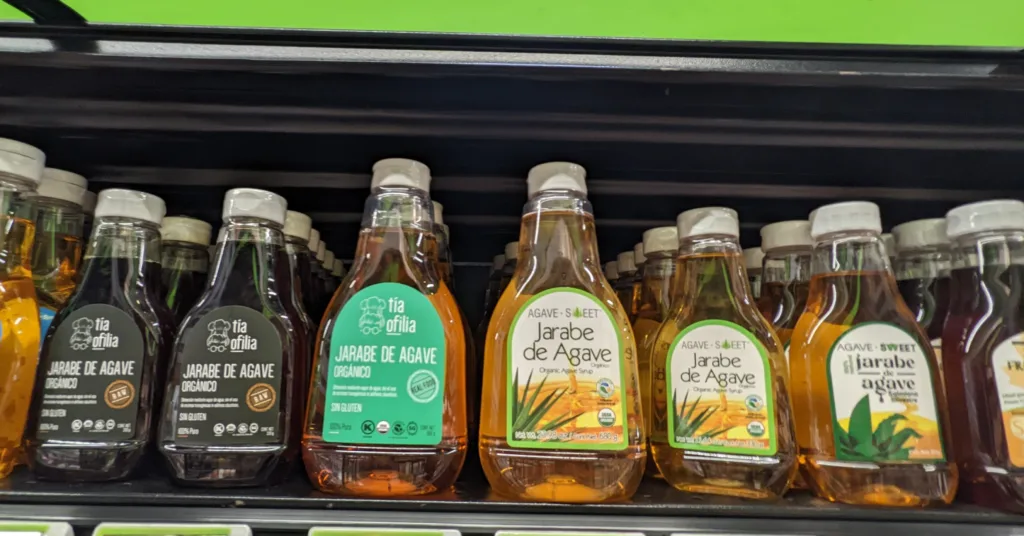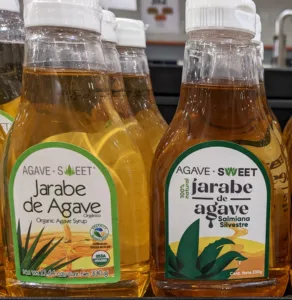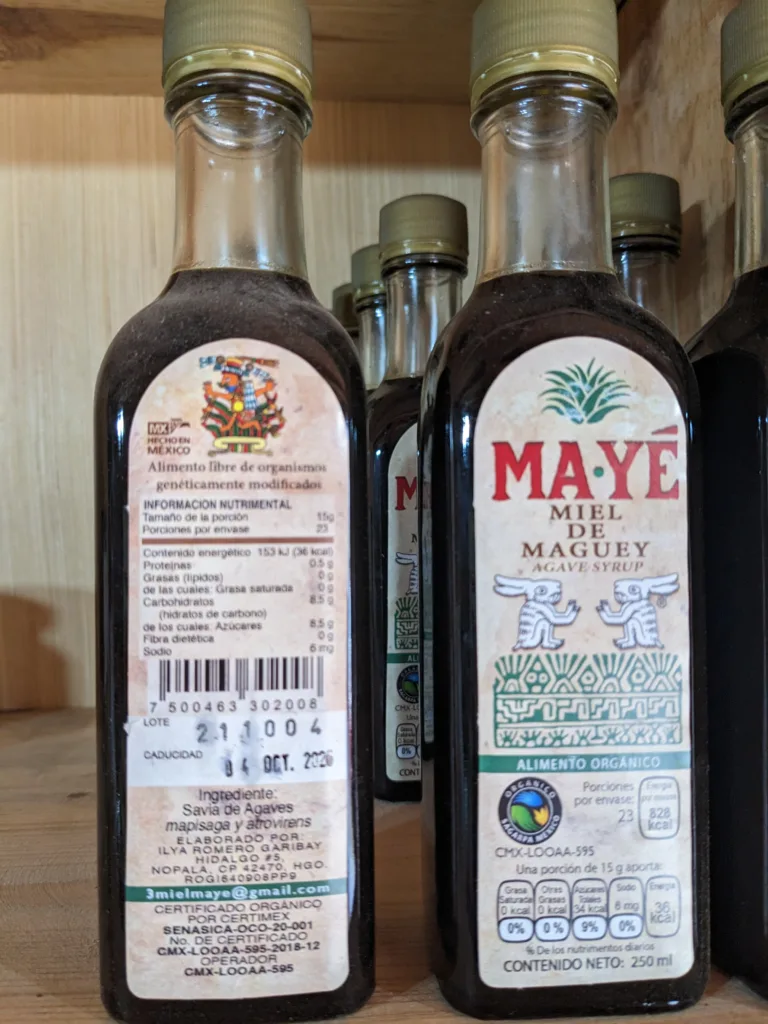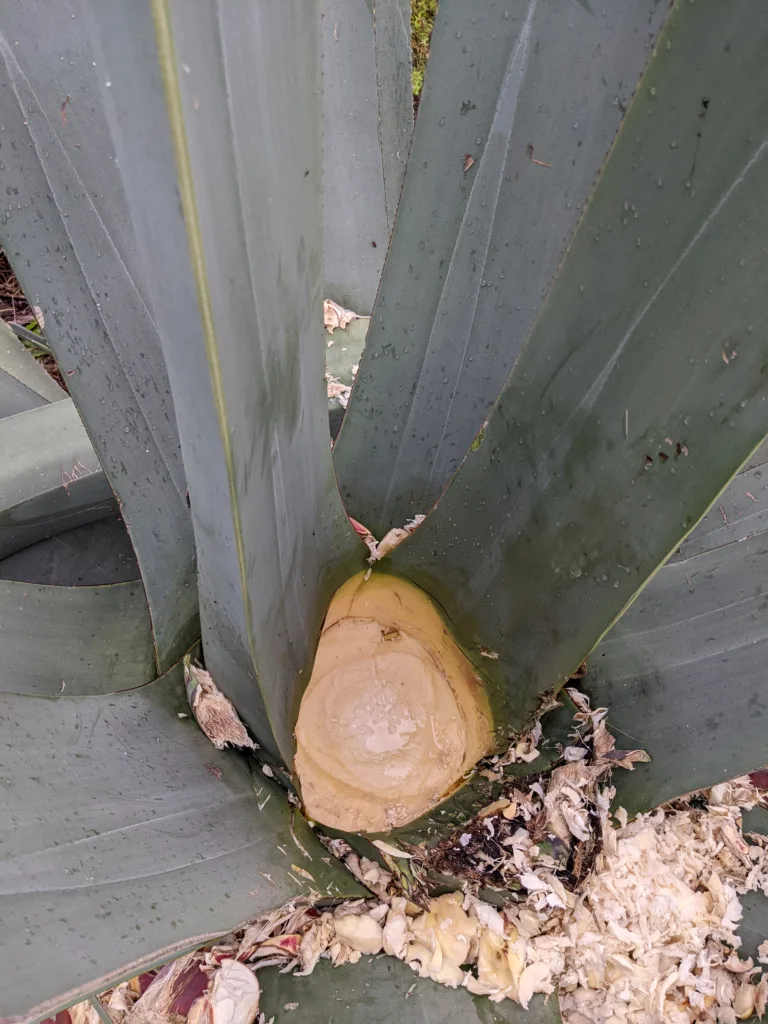Agave syrup, or nectar, is a sweetener that has been gaining popularity in recent years due to its versatility and perceived health benefits. People often proclaim its lower glycemic index than traditional sweeteners such as sugar and honey and its “natural” image. In this article, we will take an in-depth look at the uses, components, and production of agave syrup and compare it to other sweeteners on the market. Despite its “natural” image, most agave syrup actually has levels of processing similar to high fructose corn syrup. But there are some varieties that are much less processed and potentially better for you.

Table of Contents
What is agave syrup?
Agave syrup is a sweetener made from the extracted juices from the core of a mature agave plant. Agaves are a succulent native to Mexico, but also found in India, parts of Africa and Central America. Agave syrup, also known as agave nectar, is used in baking or in beverages including cocktails such as the Tommy’s Margarita, and as a sugar or honey substitute.
The syrup is made from several species of agave, most commonly agave tequiliana, or blue Weber agave which is the same variety used for making tequila.
It is a popular vegan alternative to honey. Agave syrup is also known for its low glycemic index properties and is often mentioned as a suitable sweetener for diabetics for this reason.
What kinds of agave syrups are there?
Agave syrups can differ depending on the type of agave plant used for the production, whether the plants are cultivated or wild, and the method of processing.
Types of agave syrup
| Light | Amber | Dark | |
|---|---|---|---|
| Taste | Mild, neutral flavor | Medium, caramel flavor | Stronger, caramel, molasses |
| Uses | Smoothies, tea, cocktails, baking, salad dressing | Desserts, sauces, savory food | Marinades, sauces, coffee, BBQ sauce, pancakes, French toast |
Agave syrups are often marketed in either standard or raw varieties. Apart from that there are dark, amber and light varieties. Each have comparable sweetness and sugar content but vary on flavor and their suggested uses.
Dark agave syrup has a stronger caramel flavor, light agave syrup is almost neutral tasting and amber is somewhere in between the two. The different colors and flavor profiles are achieved by different levels of filtration. The temperature used to process the syrup also affects the color. Lower temperatures result in darker colored syrups.
Raw agave syrup is generally more neutral tasting and is preferred by some in the “raw food” movement, or is considered less processed.
Types of agave used to make agave syrup.
The most common species of agave used to make agave syrup is the blue Weber agave, or agave tequilana. This is the same species of agave used to make tequila. This species is most common in the Mexican state of Jalisco. Agave salmiana and agave americana are two other commonly used species for syrup production.
These agave species are used because of their high carbohydrate content and relatively short time to maturity. The high carbohydrate content means that there are a lot of nutrients in the plant that can be converted into sugars. This means you can get more agave syrup from these types of agave than most other species. Time to maturity for these plants is around six or seven years. While this may seem like a long time, other species of agave can take more than 20 years to reach maturity.
Wild versus cultivated agave syrup

Most agave syrup sold is produced from cultivated agave. Blue Weber agave in particular is mostly farmed, especially in the Mexican state of Jalisco. Agave syrup from other species has more chance of being from wild agave, such as agave salmiana, although this species is also cultivated.
How is agave syrup made? The standard approach
The key steps to create agave syrup are harvesting the agave, milling, extraction, hydrolysis (breakdown into sugars), filtration and reduction.
1. Harvesting the agave
Agave plants are ready for harvest when they reach maturity, which can be after six or seven years. Agave plants only flower once, at the end of their lifetime. Just before they shoot up a tall stalk from the center of the plant, most of the carbohydrates will be concentrated in the core. This makes it the perfect time to harvest.
The spikey leaves of the agave plants are chopped off, leaving just the carbohydrate rich piña. The core is called piña (Spanish for pineapple) due to its resemblance to the fruit. The piña is made up of inulin, fructans and water.
Mature piñas of the type used for syrup can weigh between 25 kg and 75 kg depending on the species of agave and its growing conditions. It takes around 4.7 kg of piña to make 1 liter of syrup. So each plant can produce between 5.3 and 16 liters of agave syrup.
2. Milling and extraction of the agave
The piñas are taken to the factory where they are fed through a roller mill, which crushes them into juicy fibers. The fibers then enter a machine called a diffuser. They are rinsed at high pressure with hot water, sometimes with sulfuric acid to release its juices. This method releases up to 98%-99% of the sugars. The juice is then filtered and the fibers are typically discarded.
3. Hydrolysis of the agave juices
In their extracted form the agave juices are not very sweet and the nutritional components must be converted into sugars. The conversion process is called hydrolysis which uses special enzymes at higher temperatures to change the inulin and fructans to fructose.
The exact temperature used in the hydrolyzation process for agave syrup may vary. For “raw” agave syrups the temperature is usually limited to less than 120 °F (49 °C). For other varieties the temperature may go up to around 175 °F (74 °C).
The process for making raw agave syrup is more likely to require added enzymes to help hydrolysis where for standard syrup, heat with the naturally present enzymes is more likely to be sufficient.
Fructans are carbohydrates and are chains of sugars made up of fructose molecules. Really long chains of fructose are known as inulin. The goal of the hydrolysis is to break down these chains into higher levels of separate fructose molecules.
4. Filtration and polishing
The juices are passed through a number of filters of decreasing size. These steps remove any cloudiness to achieve a clear liquid. More filtration means a lighter colored and flavored syrup.
5. Reduction into syrup
The filtered juices are now ready to be reduced down into syrup. The reduction is made by evaporating excess water in a vacuum at around 208 °F (98 °C). For raw varieties of agave syrup, the evaporation is carried out at lower temperatures and takes longer.
6. Bottling
The finished product is kept in motion in a large tank in order to homogenize the syrup, or make sure it keeps a similar consistency. From there it is either bottled on site, or packed in bulk for bottling elsewhere.
How is agave syrup made? The less processed approach

Another way that some agave syrup is made uses far less processing but is more labor intensive. Products marketed as aguamiel and some agave nectars use this method. For the less processed approach, a tlachiquero takes sap from the still living plant and applies heat to concentrate it. This process is similar to that used to make maple syrup.
Mature agaves sprout flower stalks that can grow up to 30 feet tall. As they are sprouting they resemble an asparagus shoot. A short time after the stalks have sprouted, they are cut off at the base. The agave releases sap from where it is cut. Over the following weeks this sap is harvested twice daily, scraping each time to promote more sap production. The liquid is sucked out into a vessel, traditionally a gourd but nowadays a plastic bottle is more common.
The sap is known as aguamiel (honey water). Aguamiel can be consumed straight from the plant and has a pleasant sweet taste. If left exposed to air the aguamiel will naturally ferment from wild yeasts to become pulque. Pulque has a translucent milky appearance and has been consumed by indigenous Mexicans for thousands of years, bearing a special spiritual significance in pre-Hispanic ceremonies.
The aguamiel can also be concentrated to become a syrup, sometimes called agave nectar, aguamiel concentrate, miel de agave, miel de maguey or just aguamiel. Agave sweetener produced in this way is different to standard agave syrup because the plant is not harvested.

Agave syrup versus agave nectar
Many products sold as agave nectar are exactly the same as agave syrup. They are made using the same ingredients with the same process. The names are more used as marketing choices. However, some products sold as agave nectar use a different production method with less processing. Sometimes these sweeteners are also sold as aguamiel. You need to read the labels to figure this out.
Nectar may sound more natural and desirable. In fact the word comes from the Greek nektar, which was the name for the drink of the gods which gave immortality. Today the term nectar refers to the sweet liquid produced by flowers which is collected by bees to make honey. Agave nectar does not come from the nectar of agave flowers so the name is somewhat misleading. A more accurate name might be “concentrated agave sap”, but this doesn’t have quite the same ring to it.
Agave syrup vs sugar, honey and other sweeteners
Nutritional profile and calories
| Sweetener | Fructose | Glucose | Sucrose | Kcal per 100g |
|---|---|---|---|---|
| Agave syrup | 80% | 20% | – | 310 kcal |
| Table sugar | – | – | 100% | 387 kcal |
| Honey | 50% | 44% | 1% | 304 kcal |
| Maple syrup | 1% | 1% | 98% | 270 kcal |
| High fructose corn syrup | 55% | 45% | – | 281 kcal |
Compared to most other sweeteners agave syrup is higher in fructose. Fructose is also known as fruit sugar due to higher levels being found in fruits.
The sugars in agave syrup are typically around 80% fructose and 20% glucose. Table sugar is almost 100% sucrose, maple syrup is about 98% sucrose, and honey is about 50% fructose and 44% glucose. High fructose corn syrup is either 55% fructose / 45% glucose (when used in soft drinks) or 42% fructose, 58% glucose (when used in foods). So agave syrup is even higher in fructose than high fructose corn syrup.
Fructose and glucose are categorized as monosaccharides and sucrose is a disaccharide, made up of 50/50 fructose and glucose. Sucrose is broken back down into fructose and glucose during digestion.
Gram for gram each of fructose, glucose and sucrose contain the same number of calories. Syrups also have between 20%-30% water, so a tablespoon of sugar has more calories than a tablespoon of agave syrup or honey for instance.
Sweetness level
Different sugar types have different levels of sweetness. Fructose is the sweetest, then sucrose then glucose. Due to its very high fructose content agave syrup is sweeter than other sweeteners, and you need to use less to get the desired level of sweetness.
For instance in baking, instead of using 1 cup of table sugar, ¾ of a cup of agave syrup will achieve the same level of sweetness. When making cocktails that call for simple syrup, use half to ¾ the amount of agave syrup instead.
Glycemic Index
| Sweetener | Glycemic Index |
|---|---|
| Agave syrup | 10-20 |
| Table sugar | 60 |
| Honey | 50-70 |
| Maple syrup | 54 |
| High fructose corn syrup | 56 |
| Glucose | 100 |
| Sucrose | 60 |
| Fructose | 23 |
Fructose is classified as a low GI food, meaning it takes longer to be absorbed into your body’s bloodstream and will cause a lower spike in blood sugar. Agave syrup is a low GI food due to its high fructose levels.
The glycemic index is based around blood sugar absorption of glucose, which is the fastest absorbed sugar, and has a GI score of 100. A food with a GI of 50 is absorbed half as fast as glucose, i.e. it takes twice as long.
Agave syrup has a GI of between 10-20. Any score lower than 55 is considered “low GI” while a score of 70 or more is “high GI”. Table sugar has a GI of 60 making it “medium GI”. Honey ranges from 50-70, maple syrup is around 55 as is high fructose corn syrup. As you can see agave syrup has a much lower GI than other sweeteners.
Taste
Agave syrup has a generally neutral taste, especially lighter colored varieties. Amber and dark varieties have a more caramel flavor although it is still less distinctive than the taste of honey or maple syrup. Agave syrup does not have the same bitter after taste as artificial sweeteners.
Cost
Agave syrup is expensive compared to table sugar, but is a lot cheaper than maple syrup and most high quality honey. Agave syrup costs about 25 to 35 cents per ounce, while granulated table sugar costs 5 to 10 cents per ounce. Pure maple syrup costs around 70 to 80 cents per ounce. Prices for honey vary somewhat but commercial honey can cost around 50 to 70 cents per ounce. Simple syrup can cost around 30 to 50 cents per ounce, or much cheaper if you make it yourself with sugar and boiling water.
Processing
Despite its positioning as a “natural product” most agave syrups are highly processed. Of the common sweeteners honey is typically the least processed, and in some cases it’s as it comes straight from the beehive. Granulated sugar is arguably the most processed.
Honey
Honey is made by bees, which convert nectar they collect from flowers into honey using enzymes in their stomachs. Almost all commercially available honey comes from cultivated bee hives. The honey is collected by the bee keepers and in its simplest form is packaged without any processing. Some honey is heated and filtered to make it flow easier and to enhance shelf life. Variations in honey tend to come from the variety of flowers the bees visit as well as any processing from humans.
Maple syrup
Maple syrup is made by collecting the sap from sugar maples, then boiling this down to concentrate it into a syrup. It generally takes 40 gallons of sap to make one gallon of syrup although this can vary between trees and across the season. This process involves very little processing.
Agave syrup
Most agave syrup is made by crushing the piñas of mature agave plants, then spraying the fibers with hot water to extract the juices, hydrolyzing the juices to convert the complex carbohydrates into fructose, then further concentrating the liquid by boiling it. There are also various phases of filtration through this process and special enzymes may be added to help with the hydrolysis. This method is similar to that used to make high fructose corn syrup.
Another method of making agave syrup involves collecting the sap of still living agaves then concentrating it through heating. This method has much in common with the process used to make maple syrup.
High fructose corn syrup
To make high fructose corn syrup the starting ingredient is corn. The corn is separated into corn starch using a process involving sulfurous acid, washing, drying, crushing and spinning. The corn starch then goes through acid hydrolysis using hydrochloric acid, heat and pressure to become corn syrup. The corn syrup then further goes through enzyme conversion to become HFCS. The enzyme conversion increases the proportion of fructose to produce a sweeter product.
Granulated sugar
About 80% of sugar comes from sugar cane, with the rest from sugar beets. The sugar cane or beets are washed then crushed, with hot water used to separate the sugars from the plant matter. This liquid is then purified using sulfur dioxide, and calcium carbonate or calcium sulfite, calcium hydroxide. The purified juice is then boiled in a series of vacuum evaporators to become a sugar syrup. Alcohol and glycerine is then added which helps convert the solids to crystals. The mixture then passes through a centrifuge (high speed spinning machine) to separate out the sugar from the molasses. The sugar crystals are then dried and separated into different sizes for packaging.
Uses
Agave syrup, sugar, honey, maple syrup are widely substitutable in baking or to sweeten drinks. However anything other than sugar and light agave syrup will also add more distinctive flavor to the final product.
Agave syrup along with other sugar syrups is sometimes used as an additive in tequila production.
Some other things to keep in mind:
- Agave syrup is sweeter than sugar so less is needed to get the same sweetness.
- Agave syrup will burn easier than sugar, so use a lower cooking temperature and slightly longer cooking time (e.g. 25 degrees Fahrenheit lower and five or 6 percent longer).
- Baking with agave syrup instead of sugar will add more moisture. This can be offset if there are ways to reduce added water or liquids, say by 1 ounce per ⅔ cup of agave syrup used.
- Agave syrup will dissolve easily in drinks, even cold ones, so may be better than using straight sugar.
- Dark agave syrup is a better substitute for brown sugar than lighter syrup.
Agave syrup for specific diets
Paleo
Agave syrup is not considered true paleo due to the level of processing; specifically heating, filtration and adding enzymes. Although some authorities consider it “paleo friendly”. Aguamiel is more often considered to be paleo.
Ketogenic
Agave syrup is almost all sugars / carbs and is definitely not keto-friendly. It is sweeter than sugar and even a small amount is likely to halt ketosis.
Diabetic
While agave syrup may be better for diabetics than sugar it is still not recommended. Agave syrup has a much lower GI than table sugar, 10-20 versus 60 for table sugar. This means it is less likely to spike blood sugar levels after eating. However agave syrup is high fructose, and in large amounts may cause damage to the liver which can hurt blood glucose control.
Vegetarian
Agave syrup is suitable for vegetarian diets. No meat or fish products are used in its production.
Vegan
Agave syrup is suitable for vegan diets as it is fully plant based, and in particular is a good replacement for honey which is not vegan.
Low FODMAP
Agave syrup is very high in fructose making it unsuitable for low FODMAP diets. FODMAP stands for fermentable oligosaccharides, disaccharides, monosaccharides and polyols. These are short-chain carbohydrates which are more difficult for people to digest and can often contribute to irritable bowel syndrome (IBS). Fructose is the fermentable sugar in the monosaccharides group.
Gluten free
Agave syrup is gluten free and is safe for people with celiac disease. Tequila is also gluten free, even mixtos.
Kosher
There is nothing in the ingredients or production process that would prevent agave syrup from being kosher. Many brands of agave syrup are certified kosher.
Halal
There is nothing in the ingredients or standard production process that would prevent agave syrup from being halal. Many brands of agave syrup are certified halal.
